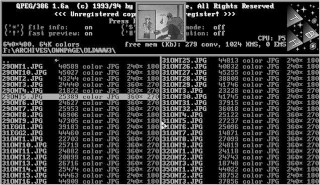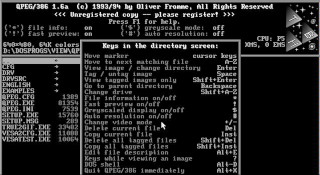Name/version: QPeg386
Archive: qpeg.zip
(Surprisingly this file doesn't seem to be in the Simtel.net archive, but a Google search will turn up archives to download it from.)
Screenshots (click on thumbnails):

Screenshot showing a tiny preview picture.

The window that appears when F1 is pressed.
Price: see below (note: author does not accept credit cards).
Documentation:
Excerpt from "\ENGLISH\QPEG.DOC":
What is QPEG386?
~~~~~~~~~~~~~~~~
QPEG386 (Quick-jPEG, pronounce "Q-Peg-386" [kju:peg]) is a viewer for JPEG
image files. It is about twice as fast as other common JPEG viewers.
Compare it yourself, you'll be surprised.
JPEG (Joint Photographic Experts Group, pronounce "Jay-Peg") is an image file
format which uses a "lossy" compression. JPEG images (they have usually a
"JPG" file extension) are normally very small and offer better compression
than any other image format.
Decoding of JPEG images is a rather complicated process, thus it needs a lot
of computing power and performance. QPEG386 takes advantage of the advanced
features of 80386, 80486 and Pentium (586) CPUs, and it uses large look-up
tables instead of formulas. Well, I don't want to get into details. It's
fast, that's all you could want to know.
Features
~~~~~~~~
- It's fast (have I mentioned that before?).
- Uses advanced features of 80386/486 processors (note, the Cyrix 486DLC
is only an improved 386 rather than a 486).
- Nice preview ability which is even faster (lets you quickly browse through
lots of images, very useful if you're searching for a certain image).
- Works even with a standard VGA card (320x200x16, 640x480x16, 320x200x256).
- Supports many SVGA cards (virtually all with VESA capability).
- Uses truecolor (16M color), hicolor (32K color), 256 color (either
greyscale or dithered color), and 16 color (dithered greyscale) modes.
- You can pan across an image which is bigger than the current screen
resolution (scrolling). Some XMS and/or EMS memory is needed for this.
You can even pan using your mouse, which is much fun (at least on fast
local bus machines).
- You can change the resolution without loading/decoding the image again
(this is restricted to the same color resolution, for example you can't
switch from hicolor to truecolor without reloading the image).
- Supports also the following image file formats (more to come):
* GIF:
+ interlaced and non-interlaced
+ GIF87a and GIF89a (87a subset only)
+ displays the first image of a multi-image GIF
* Targa (TGA):
+ truecolor (15, 16, 24 and 32 bit), greyscaled, or with palette
+ uncompressed or rle compressed (run length encoded)
+ supports all video modes (16, 256, 32K, 64K, 16M)
* PCX:
+ 1 and 4 bit with standard palette
+ 8 bit with extended palette
+ 24 bit truecolor
* BMP (Windows)
+ 1 bit monochrome with palette, uncompressed
+ 4 and 8 bit with palette, uncompressed or RLE4/8 compressed
+ 24 bit truecolor, uncompressed
* BMP (OS/2)
+ 1, 4 and 8 bit with palette, uncompressed
+ 24 bit truecolor, uncompressed
+ also supports the new multi image format (BA-BMP)
* IFF/ILBM (LBM)
+ 1 to 8 bit with palette, and 24 bit truecolor, also DP2 enhanced
+ uncompressed or compressed (ByteRun-1)
+ no HAM yet (due to lack of test images)
Requirements
~~~~~~~~~~~~
- 80386 or better CPU (33 MHz minimum recommended), 386SX is sufficient
- VGA graphics card (SuperVGA recommended, though QPEG386 will run on any
standard VGA card)
- some XMS and/or EMS memory (depending on the size of the images), though
QPEG386 will also run without any XMS/EMS, but then you will be unable to
do any panning/scrolling
- about 500 to 550 Kb of free conventional memory
- MS-DOS 5.0 or compatible operating system
A mouse is not required, but it's much more fun than keyboard control!
A numeric coprocessor is not required. If present, it will not be used,
because it would not speed up decoding/displaying.
Excerpt from "\ENGLISH\QPEG.DOC":
Please tick (see REGISTER.DOC for help, e.g. other currencies):
[] QPEG386 single private registration: 30 DM or 20 $US
[] QPEG386 single commercial registration: 60 DM or 40 $US
[] QPEG386 current shareware (no reg.!): 5 DM or 5 $US
[] QPEG386 sharew.+images on MO disk 128 Mb: 98 DM or 75 $US
[] QPEG386 sharew.+images on DC2120 (QIC80): 88 DM or 65 $US
[] JPEG Unit / source, private: 80 DM or 60 $US
[] JPEG Unit / source, single commercial: 300 DM or 220 $US
[] JPEG Unit / source, unlimited commerc.: 1200 DM or 900 $US
[] foreign cheque surcharge: 15 DM 10 $US